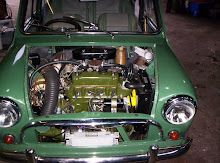Of equal importance is the green oil-pressure warning lamp which is fitted when an oil-pressure gauge is not provided. Like the ignition warning lamp, this should be extinguished as soon as the engine is running, as the contacts on the switch mounted on the engine are designed to open when the oil pressure in the lubrication system exceeds 5- 81b per sq in.
If the lamp continues to glow, the car should not be driven until the oil level in the sump has been checked. If all appears to be in order, and there is no sign of external leakage or clatter from the engine when it is cautiously speeded up, it is possible that the oil pressure-operated switch is faulty. Most garages will be able to test the switch and to check the pressure in the lubrication system by connecting a pressure gauge to the switch union. The normal running pressure is 40-70 lb per sq in.
On later models a second oil warning lamp is provided, which lights up only when the oil filter element is becoming clogged and is due for replace¬ment. The increased resistance caused by a dirty filter operates a switch on the filter housing.
Choke or Mixture Control. This control should be pulled out fully when the engine is started from cold but should be progressively returned as the engine warms up and is able to accept the weaker mixture without spitting-back or stalling in traffic. Keeping the mixture control in action
Fig. 3. The Riley Elf Mark III saloon. The Wolseley Hornet is very similar, apart from the radiator grille
too long will cause excessive fuel consumption and rapid cylinder wear.
On the other hand, since the carburettor is set to give an economical mixture strength when the engine is at its normal running temperature, misfiring and lack of power may be experienced if the mixture control is pushed home too soon after starting from cold; but the car should respond normally to the throttle after two or three miles have been covered, even in very cold weather. If it is necessary to keep the mixture control in use, carburettor adjustment, as described in Chapter 6, may cure the trouble. At the same time, check that the damper piston chamber in the carburettor is filled with the correct grade of engine oil.
Normally there should be no need to use the control when starting a warm engine; in fact, if the control is pulled out when the engine is hot, starting may be difficult or impossible, owing to the whole of the induction system being filled with an excessively rich petrol-air mixture. In such a case the only cure is to push the mixture control fully home, open the throttle wide and rotate the engine with the starter motor until the rich mixture has been cleared out of the cylinders. As soon as the engine fires, the throttle should be closed to prevent it racing.



0 comments:
Post a Comment